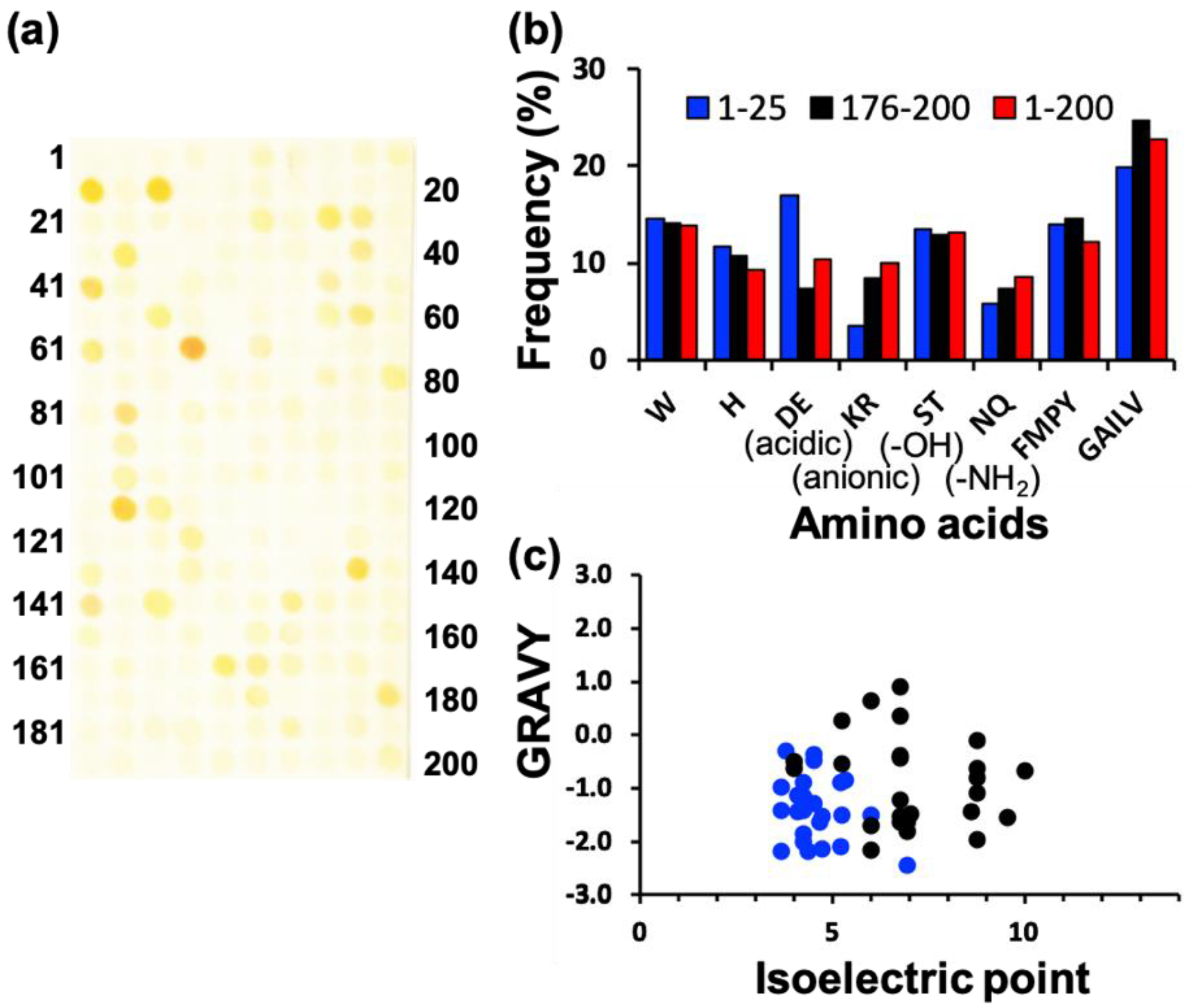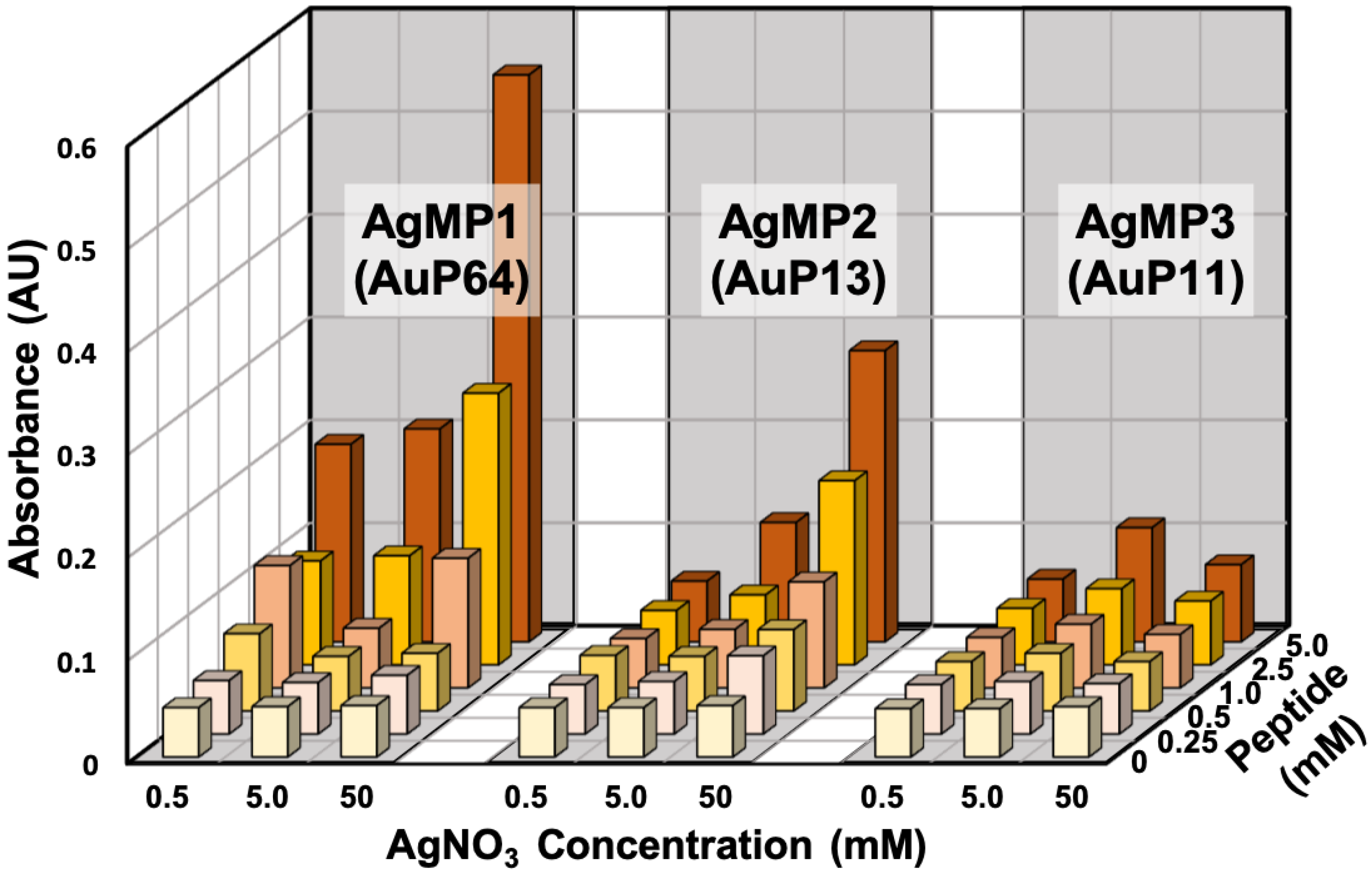Array-Based Screening of Silver Nanoparticle Mineralization Peptides
Abstract
1. Introduction
2. Results
2.1. Screening of AgNP Mineralization Peptide Using Peptide Array Consisting of AuNP-Binding Peptides
2.2. Ag Nanoparticle Synthesis by Screened Mineralization Peptides
2.3. Transmission Electron Microscopic (TEM) Observation of AgNPs Synthesized by Screened Mineralization Peptides
3. Discussion
4. Materials and Methods
4.1. Peptide Array Synthesis Using Spot Technology
4.2. Screening of AgNP Mineralization Peptides Using Peptide Array
4.3. AgNP Synthesis and Characterization Using Screened Mineralization Peptides
Supplementary Materials
Author Contributions
Funding
Conflicts of Interest
Abbreviations
| AgNP | Silver nanoparticle |
| AgMP | Silver mineralization peptide |
| AuNP | Gold nanoparticle |
| DMF | N,N′-dimethylformamide |
| pI | Isoelectric point |
References
- Zhao, L.J.; Yu, R.J.; Ma, W.; Han, H.X.; Tian, H.; Qian, R.C.; Long, Y.T. Sensitive detection of protein biomarkers using silver nanoparticles enhanced immunofluorescence assay. Theranostics 2017, 7, 876–883. [Google Scholar] [CrossRef] [PubMed]
- Okochi, M.; Kuboyama, M.; Tanaka, M.; Honda, H. Design of a dual-function peptide probe as a binder of angiotensin II and an inducer of silver nanoparticle aggregation for use in label-free colorimetric assays. Talanta 2015, 142, 235–239. [Google Scholar] [CrossRef] [PubMed]
- Jang, J.; Choi, Y.; Tanaka, M.; Choi, J. Development of silver/graphene oxide nanocomposites for antibacterial and antibiofilm applications. J. Ind. Eng. Chem. 2019, 83, 46–52. [Google Scholar] [CrossRef]
- Huard, D.J.E.; Demissie, A.; Kim, D.; Lewis, D.; Dickson, R.M.; Petty, J.T.; Lieberman, R.L. Atomic structure of a fluorescent Ag8 cluster templated by a multistranded DNA scaffold. J. Am. Chem. Soc. 2019, 141, 11465–11470. [Google Scholar] [CrossRef] [PubMed]
- Syafiuddin, A.; Salmiati; Salim, M.R.; Beng Hong Kueh, A.; Hadibarata, T.; Nur, H. A review of silver nanoparticles: Research trends, global consumption, synthesis, properties, and future challenges. J. Chin. Chem. Soc. 2017, 64, 732–756. [Google Scholar] [CrossRef]
- Lee, S.H.; Jun, B.H. Silver nanoparticles: Synthesis and application for nanomedicine. Int. J. Mol. Sci. 2019, 20, 865. [Google Scholar] [CrossRef]
- Tarannum, N.; Divya; Gautam, Y.K. Facile green synthesis and applications of silver nanoparticles: A state-of-the-art review. RSC Adv. 2019, 9, 34926–34948. [Google Scholar] [CrossRef]
- Srikar, S.K.; Giri, D.D.; Pal, D.B.; Mishra, P.K.; Upadhyay, S.N. Green synthesis of silver nanoparticles: A review. Green Sustain. Chem. 2016, 6, 34–56. [Google Scholar] [CrossRef]
- Rafique, M.; Sadaf, I.; Rafique, M.S.; Tahir, M.B. A review on green synthesis of silver nanoparticles and their applications. Artif. Cells Nanomed. Biotechnol. 2017, 45, 1272–1291. [Google Scholar] [CrossRef]
- Kasyanenko, N.; Varshavskii, M.; Ikonnikov, E.; Tolstyko, E.; Belykh, R.; Sokolov, P.; Bakulev, V.; Rolich, V.; Lopatko, K. DNA modified with metal nanoparticles: Preparation and characterization of ordered metal-DNA nanostructures in a solution and on a substrate. J. Nanomater. 2016, 2016, 3237250. [Google Scholar] [CrossRef]
- Zagorovsky, K.; Chou, L.Y.T.; Chan, W.C.W. Controlling DNA-nanoparticle serum interactions. Proc. Natl. Acad. Sci. USA 2016, 113, 13600–13605. [Google Scholar] [CrossRef] [PubMed]
- Li, H.; Rothberg, L. Colorimetric detection of DNA sequences based on electrostatic interactions with unmodified gold nanoparticles. Proc. Natl. Acad. Sci. USA 2004, 101, 14036–14039. [Google Scholar] [CrossRef] [PubMed]
- Gurme, S.T.; Aware, C.B.; Surwase, S.N.; Chavan, C.S.; Jadhav, J.P. Synthesis of melanin mediated silver nanoparticles from Aeromonas sp. SNS using response surface methodology: Characterization with the biomedical applications and photocatalytic degradation of brilliant green. J. Polym. Environ. 2019, 27, 2428–2438. [Google Scholar] [CrossRef]
- Hatanaka, T.; Matsugami, A.; Nonaka, T.; Takagi, H.; Hayashi, F.; Tani, T.; Ishida, N. Rationally designed mineralization for selective recovery of the rare earth elements. Nat. Commun. 2017, 8, 15670. [Google Scholar] [CrossRef] [PubMed]
- Tanaka, M.; Takahashi, Y.; Roach, L.; Critchley, K.; Evans, S.D.; Okochi, M. Rational screening of biomineralisation peptides for colour-selected one-pot gold nanoparticle syntheses. Nanoscale Adv. 2019, 1, 71–75. [Google Scholar] [CrossRef]
- Maeda, Y.; Makhlynets, O.V.; Matsui, H.; Korendovych, I.V. Design of catalytic peptides and proteins through rational and combinatorial approaches. Annu. Rev. Biomed. Eng. 2016, 18, 311–328. [Google Scholar] [CrossRef]
- Vallee, A.; Humblot, V.; Pradier, C.-M. Peptide interactions with metal and oxide surfaces. Acc. Chem. Res. 2010, 43, 1297–1306. [Google Scholar] [CrossRef]
- Tang, Z.; Palafox-Hernandez, J.P.; Law, W.-C.; Hughes, Z.E.; Swihart, M.T.; Prasad, P.N.; Knecht, M.R.; Walsh, T.R. Biomolecular recognition principles for bionanocombinatorics: An integrated approach to elucidate enthalpic and entropic factors. ACS Nano 2013, 7, 9632–9646. [Google Scholar] [CrossRef]
- Carter, C.J.; Ackerson, C.J.; Feldheim, D.L. Unusual reactivity of a silver mineralizing peptide. ACS Nano 2010, 4, 3883–3888. [Google Scholar] [CrossRef]
- Belser, K.; Slenters, T.V.; Pfumbidzai, C.; Upert, G.; Mirolo, L.; Fromm, K.M.; Wennemers, H. Silver nanoparticle formation in different sizes induced by peptides identified within split-and-mix libraries. Angew. Chem. Int. Ed. 2009, 48, 3661–3664. [Google Scholar] [CrossRef]
- Frank, R. The SPOT-synthesis technique: Synthetic peptide arrays on membrane supports–principles and applications. J. Immunol. Methods 2002, 267, 13–26. [Google Scholar] [CrossRef]
- Frank, R. Spot-synthesis: An easy technique for the positionally addressable, parallel chemical synthesis on a membrane support. Tetrahedron 1992, 48, 9217–9232. [Google Scholar] [CrossRef]
- Okochi, M.; Sugita, T.; Furusawa, S.; Umetsu, M.; Adschiri, T.; Honda, H. Peptide array-based characterization and design of ZnO-high affinity peptides. Biotechnol. Bioeng. 2010, 106, 845–851. [Google Scholar] [CrossRef] [PubMed]
- Okochi, M.; Ogawa, M.; Kaga, C.; Sugita, T.; Tomita, Y.; Kato, R.; Honda, H. Screening of peptides with a high affinity for ZnO using spot-synthesized peptide arrays and computational analysis. Acta Biomater. 2010, 6, 2301–2306. [Google Scholar] [CrossRef]
- Tanaka, M.; Hikiba, S.; Yamashita, K.; Muto, M.; Okochi, M. Array-based functional peptide screening and characterization of gold nanoparticle synthesis. Acta Biomater. 2017, 1, 13–26. [Google Scholar] [CrossRef]
- Kuboyama, M.; Kato, R.; Okochi, M.; Honda, H. Screening for silver nanoparticle-binding peptides by using a peptide array. Biochem. Eng. J. 2012, 66, 73–77. [Google Scholar] [CrossRef]
- Si, G.; Shi, W.; Li, K.; Ma, Z. Synthesis of PSS-capped triangular silver nanoplates with tunable SPR. Colloids Surfaces A Physicochem. Eng. Asp. 2011, 380, 257–260. [Google Scholar] [CrossRef]
- Wijaya, Y.N.; Kim, J.; Choi, W.M.; Park, S.H.; Kim, M.H. A systematic study of triangular silver nanoplates: One-pot green synthesis, chemical stability, and sensing application. Nanoscale 2017, 9, 11705–11712. [Google Scholar] [CrossRef]
- Xiong, Y.; McLellan, J.M.; Chen, J.; Yin, Y.; Li, Z.Y.; Xia, Y. Kinetically controlled synthesis of triangular and hexagonal nanoplates of palladium and their SPR/SERS properties. J. Am. Chem. Soc. 2005, 127, 17118–17127. [Google Scholar] [CrossRef]
- Le Beulze, A.; Duguet, E.; Mornet, S.; Majimel, J.; Tréguer-Delapierre, M.; Ravaine, S.; Florea, I.; Ersen, O. New insights into the side-face structure, growth aspects, and reactivity of Agn nanoprisms. Langmuir 2014, 30, 1424–1434. [Google Scholar] [CrossRef]
- Alloyeau, D.; Dachraoui, W.; Javed, Y.; Belkahla, H.; Wang, G.; Lecoq, H.; Ammar, S.; Ersen, O.; Wisnet, A.; Gazeau, F.; et al. Unravelling kinetic and thermodynamic effects on the growth of gold nanoplates by liquid transmission electron microscopy. Nano Lett. 2015, 15, 2574–2581. [Google Scholar] [CrossRef] [PubMed]
- Yamagishi, A.; Tanaka, M.; Lenders, J.J.M.; Thiesbrummel, J.; Sommerdijk, N.A.J.M.; Matsunaga, T.; Arakaki, A. Control of magnetite nanocrystal morphology in magnetotactic bacteria by regulation of mms7 gene expression. Sci. Rep. 2016, 6, 29785. [Google Scholar] [CrossRef] [PubMed]
- Yamagishi, A.; Narumiya, K.; Tanaka, M.; Matsunaga, T.; Arakaki, A. Core amino acid residues in the morphology-regulating protein, Mms6, for intracellular magnetite biomineralization. Sci. Rep. 2016, 6, 35670. [Google Scholar] [CrossRef] [PubMed]
- Grohe, B.; O’Young, J.; Ionescu, D.A.; Lajoie, G.; Rogers, K.A.; Karttunen, M.; Goldberg, H.A.; Hunter, G.K. Control of calcium oxalate crystal growth by face-specific adsorption of an osteopontin phosphopeptide. J. Am. Chem. Soc. 2007, 129, 14946–14951. [Google Scholar] [CrossRef]
- Ndao, M.; Ash, J.T.; Stayton, P.S.; Drobny, G.P. The role of basic amino acids in the molecular recognition of hydroxyapatite by statherin using solid state NMR. Surf. Sci. 2010, 604, L39–L42. [Google Scholar] [CrossRef]
- Deshpande, A.S.; Beniash, E. Bioinspired synthesis of mineralized collagen fibrils. Cryst. Growth Des. 2008, 8, 3084–3090. [Google Scholar] [CrossRef]
- Tanaka, M.; Suwatthanarak, T.; Arakaki, A.; Johnson, B.R.G.; Evans, S.D.; Okochi, M.; Staniland, S.S.; Matsunaga, T. Enhanced tubulation of liposome containing cardiolipin by MamY protein from magnetotactic bacteria. Biotechnol. J. 2018, 13, e1800087. [Google Scholar] [CrossRef]
- Alvin, A.W.L.; Tanaka, M.; Okochi, M. Characterization of particulate matter binding peptides screened from phage display. J. Biosci. Bioeng. 2017, 123, 621–624. [Google Scholar] [CrossRef]



| Peptide No. | Sequence | Mineralization Activity 1 | pI 2 | GRAVY2 2 |
|---|---|---|---|---|
| AuP64 (AgMP1) | AESEHEWEVA | 162.9 | 4.09 | −1.11 |
| AuP13 (AgMP2) | EEPHWEEMAA | 168.2 | 4.09 | −1.42 |
| AuP11 (AgMP3) | PEESQEGWMA | 168.2 | 3.67 | −1.4 |
| AuP112 (AgMP4) | NWELEEHSAS | 169.4 | 4.24 | −1.41 |
| AuP139 (AgMP5) | ETEWLGHETL | 174.7 | 4.24 | −0.88 |
| AuP41 (AgMP6) | WSEETEMWPL | 177.8 | 3.67 | −0.97 |
| AuP82 (AgMP7) | WQENSMEENW | 183.9 | 3.67 | −2.17 |
| AuP180 (AgMP8) | HWWWEHEMEH | 185.1 | 5.22 | −2.09 |
| AuP165 (AgMP9) | EGSDHPSWNQ | 186.0 | 4.35 | −2.17 |
| AuP28 (AgMP10) | PEEGPHSLWH | 186.3 | 5.23 | −1.49 |
| Peptide No. | Sequence | Mineralization Activity 1 | pI 2 | GRAVY 2 |
|---|---|---|---|---|
| AuP77 | YWASHKHWWW | 221.2 | 8.61 | −1.42 |
| AuP173 | WMMWGWVHEI | 221.6 | 5.24 | 0.27 |
| AuP65 | TQWHEWHWYQ | 221.9 | 5.98 | −2.16 |
| AuP155 | NWTHWSTTQH | 222.0 | 6.92 | −1.81 |
| AuP137 | VHYGSQIEWG | 222.7 | 5.24 | −0.53 |
| AuP95 | AHALWIWHKT | 223.0 | 8.76 | −0.09 |
| AuP125 | TTWHGFPWAG | 223.1 | 6.74 | −0.42 |
| AuP74 | VLWRHEWAWK | 223.1 | 8.75 | −0.80 |
| AuP116 | WHHWAQGWHG | 223.5 | 7.02 | −1.48 |
| AuP117 | YEAVSTTWQS | 224.0 | 4.00 | −0.62 |
© 2020 by the authors. Licensee MDPI, Basel, Switzerland. This article is an open access article distributed under the terms and conditions of the Creative Commons Attribution (CC BY) license (http://creativecommons.org/licenses/by/4.0/).
Share and Cite
Tanaka, M.; Saito, S.; Kita, R.; Jang, J.; Choi, Y.; Choi, J.; Okochi, M. Array-Based Screening of Silver Nanoparticle Mineralization Peptides. Int. J. Mol. Sci. 2020, 21, 2377. https://doi.org/10.3390/ijms21072377
Tanaka M, Saito S, Kita R, Jang J, Choi Y, Choi J, Okochi M. Array-Based Screening of Silver Nanoparticle Mineralization Peptides. International Journal of Molecular Sciences. 2020; 21(7):2377. https://doi.org/10.3390/ijms21072377
Chicago/Turabian StyleTanaka, Masayoshi, Shogo Saito, Reo Kita, Jaehee Jang, Yonghyun Choi, Jonghoon Choi, and Mina Okochi. 2020. "Array-Based Screening of Silver Nanoparticle Mineralization Peptides" International Journal of Molecular Sciences 21, no. 7: 2377. https://doi.org/10.3390/ijms21072377
APA StyleTanaka, M., Saito, S., Kita, R., Jang, J., Choi, Y., Choi, J., & Okochi, M. (2020). Array-Based Screening of Silver Nanoparticle Mineralization Peptides. International Journal of Molecular Sciences, 21(7), 2377. https://doi.org/10.3390/ijms21072377






